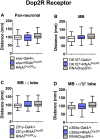Dop1R1, a type 1 dopaminergic receptor expressed in Mushroom Bodies, modulates Drosophila larval locomotion
- PMID: 32101569
- PMCID: PMC7043742
- DOI: 10.1371/journal.pone.0229671
Dop1R1, a type 1 dopaminergic receptor expressed in Mushroom Bodies, modulates Drosophila larval locomotion
Abstract
As in vertebrates, dopaminergic neural systems are key regulators of motor programs in insects, including the fly Drosophila melanogaster. Dopaminergic systems innervate the Mushroom Bodies (MB), an important association area in the insect brain primarily associated to olfactory learning and memory, but that has been also implicated with the execution of motor programs. The main objectives of this work is to assess the idea that dopaminergic systems contribute to the execution of motor programs in Drosophila larvae, and then, to evaluate the contribution of specific dopaminergic receptors expressed in MB to these programs. Our results show that animals bearing a mutation in the dopamine transporter show reduced locomotion, while mutants for the dopaminergic biosynthetic enzymes or the dopamine receptor Dop1R1 exhibit increased locomotion. Pan-neuronal expression of an RNAi for the Dop1R1 confirmed these results. Further studies show that animals expressing the RNAi for Dop1R1 in the entire MB neuronal population or only in the MB γ-lobe forming neurons, exhibit an increased motor output, as well. Interestingly, our results also suggest that other dopaminergic receptors do not contribute to larval motor behavior. Thus, our data support the proposition that CNS dopamine systems innervating MB neurons modulate larval locomotion and that Dop1R1 mediates this effect.
Conflict of interest statement
The authors have declared that no competing interests exist.
Figures






Similar articles
-
Serotonin receptors expressed in Drosophila mushroom bodies differentially modulate larval locomotion.PLoS One. 2014 Feb 25;9(2):e89641. doi: 10.1371/journal.pone.0089641. eCollection 2014. PLoS One. 2014. PMID: 24586928 Free PMC article.
-
The role of dopamine in Drosophila larval classical olfactory conditioning.PLoS One. 2009 Jun 12;4(6):e5897. doi: 10.1371/journal.pone.0005897. PLoS One. 2009. PMID: 19521527 Free PMC article.
-
Unveiling the Dual Role of the Dopaminergic System on Locomotion and the Innate Value for an Aversive Olfactory Stimulus in Drosophila.Neuroscience. 2018 Feb 10;371:433-444. doi: 10.1016/j.neuroscience.2017.12.032. Epub 2017 Dec 29. Neuroscience. 2018. PMID: 29292079
-
Drosophila memory: dopamine signals punishment?Curr Biol. 2005 Nov 22;15(22):R932-4. doi: 10.1016/j.cub.2005.10.058. Curr Biol. 2005. PMID: 16303554 Review.
-
Bridging behavior and physiology: ion-channel perspective on mushroom body-dependent olfactory learning and memory in Drosophila.J Cell Physiol. 2006 Dec;209(3):1046-53. doi: 10.1002/jcp.20764. J Cell Physiol. 2006. PMID: 16924658 Review.
Cited by
-
Loss-of-Function Variants in DRD1 in Infantile Parkinsonism-Dystonia.Cells. 2023 Mar 30;12(7):1046. doi: 10.3390/cells12071046. Cells. 2023. PMID: 37048120 Free PMC article.
-
Low-nutrient diet in Drosophila larvae stage causes enhancement in dopamine modulation in adult brain due epigenetic imprinting.Open Biol. 2023 May;13(5):230049. doi: 10.1098/rsob.230049. Epub 2023 May 10. Open Biol. 2023. PMID: 37161288 Free PMC article.
-
Nighttime caffeine intake increases motor impulsivity.iScience. 2025 Jul 24;28(8):113197. doi: 10.1016/j.isci.2025.113197. eCollection 2025 Aug 15. iScience. 2025. PMID: 40809001 Free PMC article.
-
Cyto-Genotoxic and Behavioral Effects of Flubendiamide in Allium cepa Root Cells, Drosophila melanogaster and Molecular Docking Studies.Int J Mol Sci. 2023 Jan 13;24(2):1565. doi: 10.3390/ijms24021565. Int J Mol Sci. 2023. PMID: 36675079 Free PMC article.
-
Optimized design and in vivo application of optogenetically functionalized Drosophila dopamine receptors.Nat Commun. 2023 Dec 19;14(1):8434. doi: 10.1038/s41467-023-43970-0. Nat Commun. 2023. PMID: 38114457 Free PMC article.
References
-
- Meder D, Herz DM, Rowe JB, Lehericy S, Siebner HR. The role of dopamine in the brain—lessons learned from Parkinson's disease. Neuroimage. 2018. - PubMed
-
- Chang HY, Grygoruk A, Brooks ES, Ackerson LC, Maidment NT, Bainton RJ, et al. Overexpression of the Drosophila vesicular monoamine transporter increases motor activity and courtship but decreases the behavioral response to cocaine. Mol Psychiatry. 2006;11(1):99–113. 10.1038/sj.mp.4001742 - DOI - PubMed
Publication types
MeSH terms
Substances
Associated data
LinkOut - more resources
Full Text Sources
Molecular Biology Databases
Research Materials
Miscellaneous

